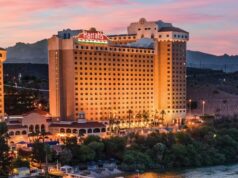NATIONAL REPORT—State-of-the-art concrete building systems can save a hotel owner money through energy savings. But equally important, concrete systems can provide hotel guests with a comfortable, healthy, environmentally friendly place to relax during their time away from home. Concrete can provide a sustainable structure that will maintain its durability, energy savings and beauty for the full life of the building.
Hotels built with concrete wall, floor and roof systems that incorporate rigid foam insulation with concrete, have optimal energy performance because of their inherent thermal mass properties. Thermal mass has the ability to store heat during the hottest periods of the day and release the heat during cooler periods. This means building owners can lower heating and cooling bills. Hotel guests within these structures are more comfortable because the inside temperature is more evenly maintained throughout the day.
Tilt-up concrete sandwich panels and insulating concrete forms are just two examples of concrete systems that incorporate rigid foam insulation and concrete for optimum energy performance. In the winter season, the high thermal mass concrete absorbs radiant heat from the sun and is gradually released back into the building during the night when the outdoor temperature drops. During the summer season, heat is absorbed by the concrete exterior during the day, reducing internal temperatures.
Additionally, because of its inherently light color, concrete used for exterior walls, roofs, and parking areas minimizes the effects that produce urban heat islands. Studies have shown that urban environments have higher temperatures in areas where there are few trees, and a multitude of paved surfaces and buildings. This additional heat causes air-conditioning systems to work harder, which uses more energy (up to 18 percent more) and promotes the formation of smog. Light-colored building materials absorb less heat and reflects more light than dark-colored materials—thereby reducing heat gain. Light colored walls and roofs, along with light colored pavements, also require less site lighting to provide safe night-time illumination levels.

A Reflection of Consumer Demand
Consumers have begun demanding that businesses, including hotels, maintain the same level of environmental consciousness as they would in their own homes. Many hotels have embraced this idea by providing their guests with the choice to use their linens for their entire stay, thus saving water and detergent, or by providing recycling bins for newspapers or magazines in hotel lobbies. Concrete can contribute to the overall environmental performance of a building in several ways.
Many recycled products such as fly ash that would otherwise clog landfills can be added to concrete mixes to improve performance. Using these by-products reduces reliance on raw materials. For example, in 2005, the concrete industry used 13.6 million metric tons of fly ash in concrete––a by-product of coal combustion at electric power utility plants. In addition, the concrete industry consumed over 3.5 million metric tons of slag cement in 2005—a by-product of steel making.
In addition to the use of fly ash in the concrete mix, used concrete can be crushed and recycled as aggregate. This new concrete with the recycled aggregate is often used as paving, backfill or a road base. Even the reinforcing steel in concrete (which often is made from recycled materials) can be recycled and reused. Concrete also provides the distinct benefit of being a locally produced material. The use of locally manufactured materials reduces the environmental impact of transporting the building material long distances. Also, using concrete that is produced and manufactured in the same community as the construction site supports the local economy.
Indoor air quality can directly impact the quality of a hotel guest’s stay. Poor indoor air quality (IAQ) can impact asthma or cause irritation to their eyes, nose and throat. Poor IAQ can result in nose bleeds, skin rashes, headaches, upper respiratory distress and dizziness. IAQ can be impacted by cigarette or tobacco smoke, high volatile organic compound (VOC) levels (due to materials used in laminate, particleboard, hardboard, treated wood, etc.), carpeting, cleaning materials, and air pollution, among others.

Concrete’s IAQ Contribution
Concrete has one of the lowest levels of VOCs and off-gassing when compared to other commonly used building materials. Concrete, when used on the exterior envelope of the building, reduces the amount of air infiltration into the building, therefore, reducing the amount of airborne moisture entering the building. This provides for better air quality, less chance of mold growth, and more efficient use of the HVAC system.
Pervious concrete is a performance-engineered concrete with a 15 to 30 percent void system that allows rainwater to percolate through it. When pervious concrete is used for parking areas, streets, plazas and walkways, it minimizes stormwater runoff to surrounding streams and lakes and allows for natural filtration to recharge local groundwater supplies. Pervious concrete reduces the need for expensive stormwater drainage and wet pond retention systems, thereby allowing for more economical and beneficial land use. Although pervious concrete has been used in some areas for decades, recent interest in green building and recognition of pervious pavements by the U.S. EPA as a best practice for stormwater management has heightened interest in its use throughout North America.
Concrete structures have withstood the test of time. For a building to last for generations, durability must be an inherent quality of the construction material. Not only will concrete last for years, it will not rust, rot, or burn, requiring less energy and resources over time to repair or replace. Concrete used for buildings and pavements are durable, long-lasting structures. Because of its longevity, concrete is a viable solution for environmentally responsible design and requires less maintenance over the lifetime of the building.
The use of concrete for hotel construction is the responsible environmentally friendly choice that will provide the hotel owner with an energy efficient building and provides hotel guests with optimal comfort and health. Concrete is a durable material made from recycled materials that can provide for long-term sustainable construction.
Go to the National Ready Mix Concrete Assn. for more details.







